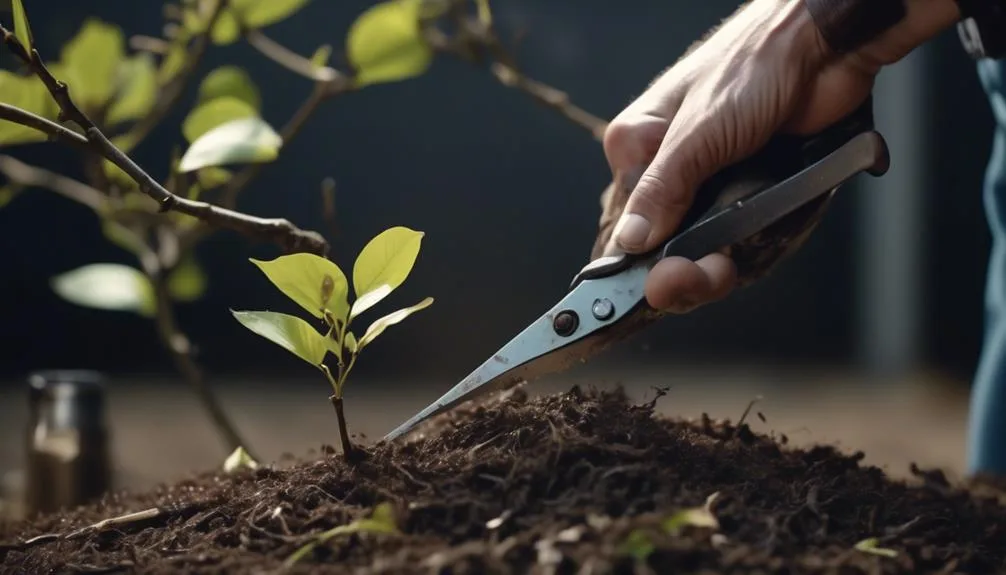Gardening offers the joy of creating new life from cuttings.
Dogwood trees, known for their beautiful blooms, are a top choice for many gardeners.
Ever thought about growing your own dogwood tree from a cutting? It's a fascinating process that lets you replicate your favorite tree and share it with others.
But how do you start? It all begins with selecting the right cutting, setting the stage for an intriguing journey into propagation.
Selecting the Right Cutting
To ensure successful propagation, select a healthy, disease-free cutting that's approximately 4-6 inches long with several leaf nodes. When taking the cutting, make a clean cut just below a leaf node at a 45-degree angle. Dip the cut end in rooting hormone to encourage root development.
Prepare a well-draining potting mix and ensure it's moist but not waterlogged. The soil moisture is crucial for the cutting's successful root development. Too much water can lead to rot, while too little can cause the cutting to wither. Gently insert the cutting into the soil, making sure at least two leaf nodes are buried.
Place the pot in a warm, bright location, and keep the soil consistently moist. With proper care, your cutting should develop roots in a few weeks.
Preparing the Cutting
Prepare the cutting by selecting a healthy, disease-free stem that's 4-6 inches long with several leaf nodes. Use a sharp, clean pair of pruning shears to make a clean cut just below a set of leaves. Remove any flowers or buds from the cutting, as they can divert energy from root development.
Ensure the cutting is taken from the current season's growth and is free from any signs of disease or damage. Once you have the cutting, place it in a plastic bag with a damp paper towel to keep it moist until you're ready to plant. This will help maintain the cutting's moisture content and prevent it from drying out.
Moist soil is essential for successful rooting, so keeping the cutting hydrated is crucial for propagation success.
Rooting the Cutting
After selecting a healthy, disease-free stem and preparing the cutting, the next step is to focus on rooting the cutting to establish a new dogwood tree. For successful rooting, you can use water propagation or hormone application to encourage the development of roots. Here's a simple comparison to help you decide which method to use:
| Rooting Method | Description | Advantages |
|---|---|---|
| Water Propagation | Placing the cutting in water until roots develop | Easy and cost-effective |
| Hormone Application | Using rooting hormone on the cutting before planting | Stimulates faster root growth |
Both methods have their benefits, so choose the one that best suits your preferences and resources. Once the roots are established, your new dogwood tree will be ready for planting.
Caring for the Cutting
For optimal growth, provide consistent moisture and avoid direct sunlight when caring for the cutting of your dogwood tree. After rooting, it's crucial to continue nurturing the cutting to ensure its successful development into a healthy tree.
Here are a few essential tips for caring for your dogwood tree cutting:
- Water Requirements: Ensure the cutting receives adequate water, keeping the soil consistently moist but not waterlogged to support root development and overall growth.
- Pruning Techniques: Regularly inspect the cutting for any dead or diseased tissue and promptly prune it to encourage healthy growth and prevent potential issues.
- Shade Protection: Shield the cutting from direct sunlight, as excessive sun exposure can stress the young plant. Consider providing partial shade to protect it from harsh sunlight.
Following these care tips will help your dogwood cutting thrive as it continues its journey to becoming a beautiful, mature tree.
Transplanting the Cutting
To ensure the successful development of your dogwood tree cutting, the next crucial step involves transplanting it into a suitable growing environment.
Choose a container that's at least 6 inches deep and has drainage holes to prevent waterlogging.
Fill the container with well-draining soil, such as a mixture of peat moss, perlite, and pine bark.
Moisten the soil before planting the cutting to ensure it's adequately hydrated.
Place the container in a location that receives filtered sunlight, as direct sunlight can be too harsh for the young cutting.
Keep the soil consistently moist but not waterlogged, and avoid letting it dry out completely.
With proper soil preparation, watering, the right container size, and sunlight exposure, your dogwood cutting will have the best chance of thriving in its new environment.
Conclusion
As you nurture your newly propagated dogwood trees, remember the careful selection, preparation, and attention that brought them to life.
With patience and care, your garden will soon flourish with these beautiful additions, enriching your surroundings for years to come.
Happy gardening!

My interest in trees started when I first saw the giant sequoias in Yosemite.
I was a teenager then, and I remember thinking, “I need to learn more about this.”
That moment stuck with me.
A few years later, I went on to study forestry at Michigan Tech.
Since graduating, I’ve worked in a mix of hands-on tree care and community education.
I’ve spent over ten years helping people understand how to plant, maintain, and protect the trees in their neighborhoods.
I don’t see trees as just part of the landscape.
They are living things that make a real difference in our daily lives.
